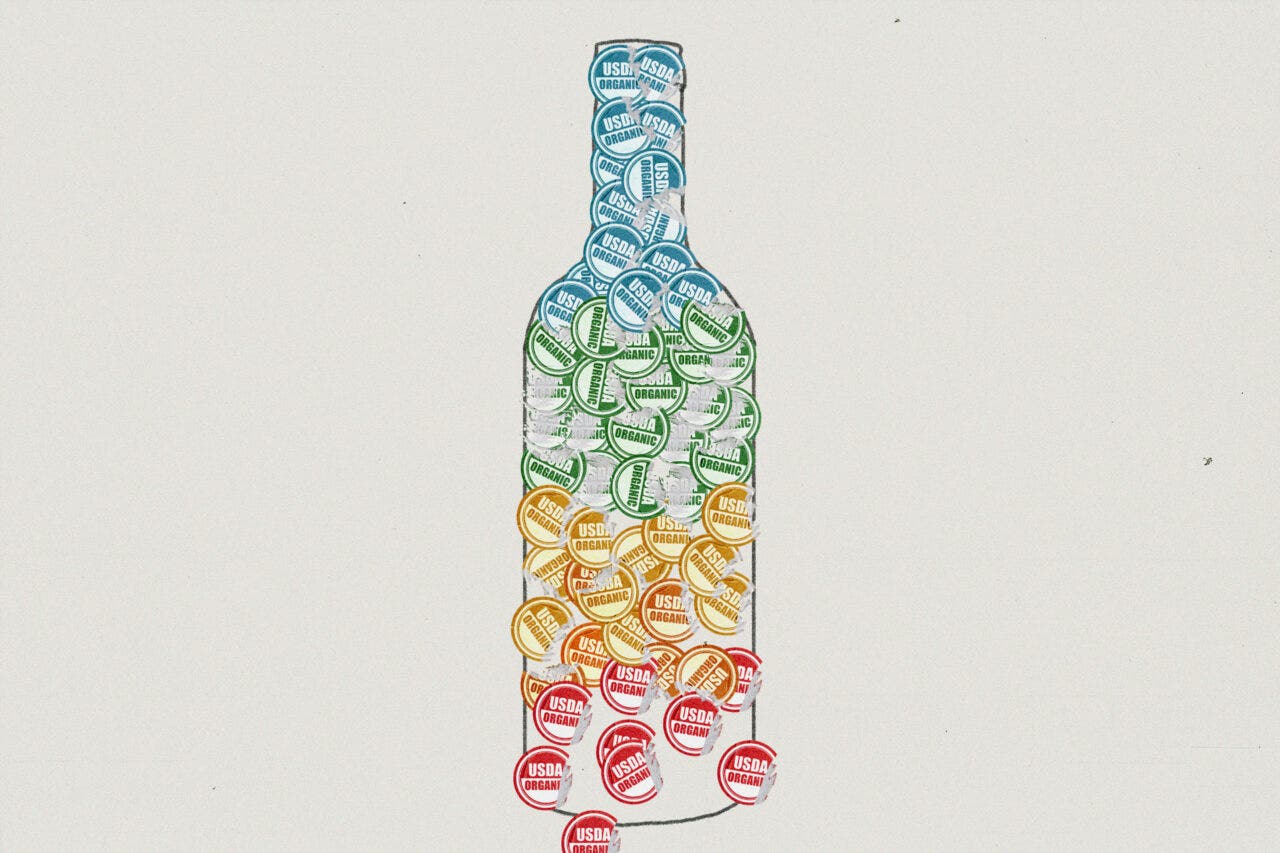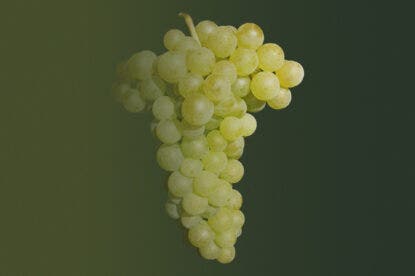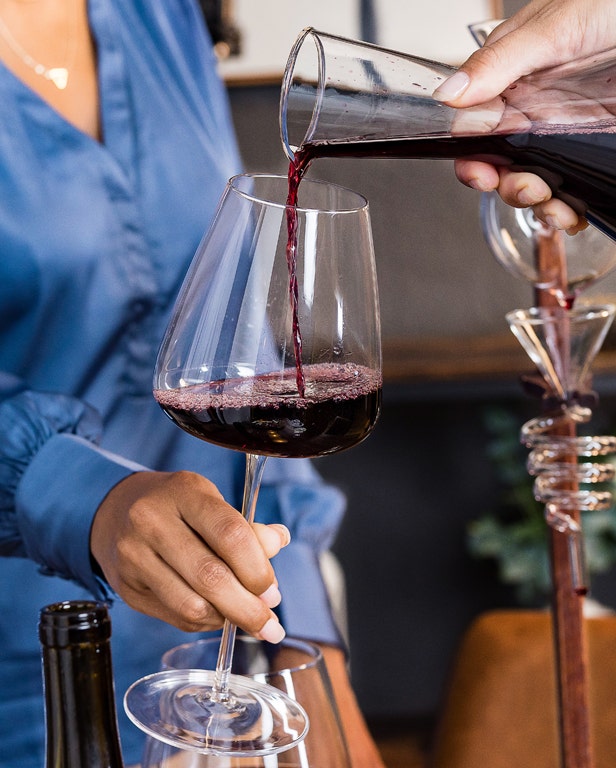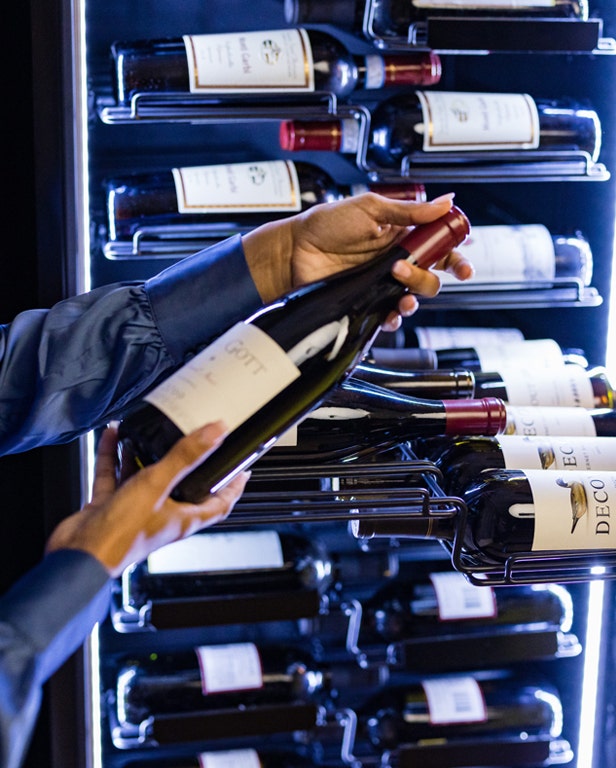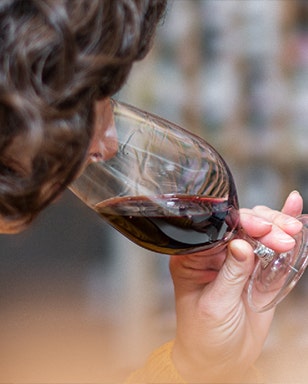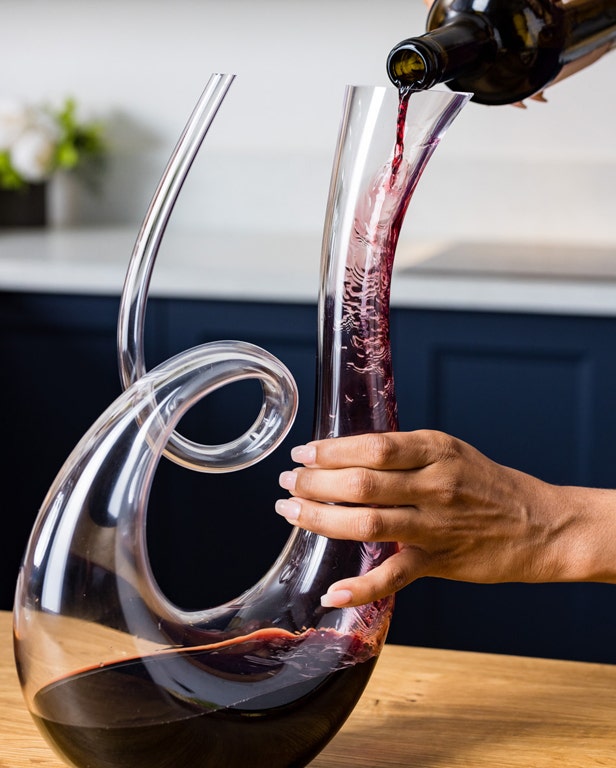Thirty years ago, Jenny Lefcourt fell in love with organic wine while studying French film in Paris. She’d sip expressive wines made by organic farmers and vignerons and stuff her suitcase with bottles to bring back to American soil.
By the early aughts, she had opened her own wine-importing business, Jenny & Francois, to preach the gospel of these wild, environmentally-conscious bottles.
Twenty years later, she’s largely responsible for igniting the natural wine movement in the United States. Her portfolio reads like a who’s who of organic and biodynamic producers, representing cult-favorites including Gut Oggau in Austria, Domaine Binner in Alsace and Hiyu Wine Farm in Hood River, Oregon.
You May Also Like: The Beginner’s Guide to Natural Wine
But a new law from the U.S. Department of Agriculture (USDA) has entirely upended Lefcourt’s and many other sustainably-minded wine pros’ business models—and may make it even harder for consumers to determine which bottles and producers share their values. A series of new directives from the agency are shifting the definition of organic wine in the U.S., leaving many longstanding organic winemakers, importers and distributors scrambling to meet stringent new standards.
While these rules were set to protect and better define the term “organic,” many find the requirements confusing, chaotic and overly strict. International vintners are in limbo, unsure if they can continue operating in the U.S. market. Lefcourt feels as if she’s being pushed out of the category she helped form. “It’s devastating,” she says.
Understanding the New USDA Rule
In January of 2023, the USDA announced that it would implement a new range of directives around importing organic products, known as the Strengthening Organic Enforcement (SOE) rule. The focus is on safeguarding the organic supply chain from tip to toe, ensuring accountability and traceability and enforcing organic labeling at every checkpoint.
“USDA’s SOE rule was necessary to better protect organic businesses and consumers,” says a USDA spokesperson. “The rule gives us tools to oversee the supply chain more fully to keep fraud out of the market.”
These new regulations are rigorous. Producers are now required to fill out additional paperwork that many feel is overly arduous, including sending an electronic organic import certificate with every shipment. Every single handler—distributor, broker, packager and beyond—of organic goods must now be certified as USDA organic. That means it’s not just the folks who grow the grapes and turn them into wine that need to be certified organic; it’s the people who bring the bottles into the country and land them at your favorite wine bars.
“We don’t touch the juice. We don’t rebottle it and we’re not farmers,” says Lefcourt. “Why are we required to get certified? It’s incomprehensible.”
You May Also Like: Your Guide to Sustainable Wine Certifications
To become certified, importers must self-audit and adopt rigorous traceability practices (tracking the movement, sale, custody and handling of an organic product), submit an application and fees, wait for review, undergo a site inspection, then wait for approval. “We must maintain current records from our certified products and suppliers, identify organic products on shipping orders and bill of ladings in a certain way, maintain fraud protection protocols… the list goes on,” says Jordan Sager, co-president of Winesellers Ltd.
Certification can cost between several hundred to thousands of dollars, depending on the size and complexity of the operation. Additionally, there are annual renewal fees, assessment fees based on annual sales and the cost of annual inspections. (The USDA Organic Certification Cost-Share program offers reimbursement of up to 75%.)
Companies had until March 19 to complete the process, though the USDA representative noted “[we] understand that not all companies will have completed the certification process before the deadline. Therefore, we consider an operation’s progress against that goal before taking enforcement action.”

From the Shop
Full Grain Buffalo Leather 6-Bottle Wine Bag
This versatile messenger-style wine bag comes with removable bottle liners, a corkscrew and an aerator.
What’s Behind These New Rules?
On one hand, the USDA’s attention towards organic produce, a category increasingly wrought with greenwashing, is a bright spot for the industry. It’s an official co-sign on the work of organic producers.
“The new regulations have been received favorably by our winery partners that embrace organic practices: it validates their organic claims,” says Scott Ehrlich, VP of Marketing for Wilson-Daniels. His importing profile includes GAJA, Domaine de la Romanée-Conti and biodynamic Loire Valley pioneers Clau de Nell. “For customers that are aware of the new regulations, it provides confidence that organic claims on imported wines have been validated by recognized accrediting organizations; otherwise, the wines would not be allowed to enter the country.”
Natural, organic and biodynamic wines are more popular than ever. “People are willing to pay a premium when it comes to organic produce and food products,” says Matt Dennie, COO at Rumor. But as organic agriculture reaches the mainstream, deceptive advertising has become rampant.
It’s particularly easy to dupe consumers in wine, a category that requires a deep knowledge to navigate confidently. For the average drinker, it’s tough enough to decode the region, varieties and sub-appellations on a bottle, let alone figure out whether the grapes are grown organically or if a bottle is full of additives and mega purple, the sugary grape concentrate that wineries around the world use to enhance the color of their wine.
You May Also Like: Warning Labels on Alcohol Are Coming. Will Drinkers Even Care?
In 2020 and 2021, wines with less sugar or lower calories started advertising that they were “cleaner” or “better-for-you”—a paradoxical claim for alcohol, which, health experts warn, is not good for anyone under any circumstances. As a response, in 2022, the Alcohol and Tobacco Trade and Tax Bureau (TTB) published an announcement stating that “clean” can be used as a taste descriptor, but not a health claim.
The new USDA initiatives are similarly aimed at increasing transparency and curbing the number of producers who claim organic practices, but don’t walk the walk. To be labeled organic, international producers must meet USDA organic regulations. USDA-certified organic wines can contain virtually no additives or sulfites (the European Union allows up to 100 parts per million of sulfites).
Frédéric Brouca, who produces expressive organic wines out of Faugères, France, thinks the rules will make organic rules clearer for drinkers. “I generally think the USDA certification is better for consumers and more in line with the principles of organic farming,” he says. Lefcourt agrees on the benefits of a certification. “I am all for protecting the consumer through stringent rules around organic certifications,” she says. “It’s very important, for clarity’s sake and to avoid fraud.”
Understanding the Upset
So, what’s causing the backlash? While the thinking behind the USDA’s new rules are in the right place—protecting the providence of organically-made wines—they didn’t stick the proverbial landing. The roll-out was fast and left small producers and importers annoyed, jilted and scrambling to understand what’s required of them.
“There was so much confusion early on as to who had to become certified and who qualified for exemptions,” says Sager. He, and many other packaged good importers, thought he was exempt. “We found out through industry chatter and guidance from trade associations that all importers must be certified. Distributors are exempt, unless they also import organic goods directly from producers they represent locally. This had many of us scrambling at the 11th hour to get certified.”
The clarity of the new requirements has been a major issue, mainly because none of the USDA’s resources are specific to the wine industry. There are four categories of USDA organic products: crops, livestock, wild crops and processed products. The last category includes “items that have been handled and packaged (i.e. chopped carrots) or combined, processed and packaged,” like soup, salad or mac and cheese—and wine.
There are 80 pages of documents detailing the new rules on the USDA website. Wine is not mentioned at all. (It doesn’t help that the TTB’s guidelines on wine importing have not been updated since 2010.) It’s a headache to navigate, and “these rules have become impossible,” says Lefcourt. “They’re slowing down my importing and my business because I can’t find the correct information. It’s incredibly confusing, costly and time consuming—it feels like a big money grab.”
You May Also Like: Wine Importers Battle an Increasingly Volatile Market
Zev Rovine, who handles a large portfolio of organic and natural producers, has found getting certified was nothing but sending in paperwork and a big check. “I don’t really see anything in the regulations that are designed around transparency or quality control,” he says.
“Over the last five years, we’ve had the French tariffs, lack of containers, the shipping crisis caused by wars, the current state of the economy and the rising price of electricity,” Lefcourt continues. “There are less sommeliers and restaurants are struggling. Then the government adds this enormous, costly burden? It’s unfair.”
Producers are as frustrated as importers. Many have spent time and money meeting the organic requirements in the E.U. Now they have a new list of rules to follow.
To put it into context, consider the wines of Parés Baltà, a leading organic and biodynamic producer based out of Penedes, Spain. The 300-year-old winery has been certified organic since 2002, and certified biodynamic with Demeter since 2012. Their efforts are evident—cover crops bloom between the vines and are pollinated by bees that live in on-site beehives. Sheep dot the vineyards and help fertilize the soil. The operation employs chamomile to regulate nitrogen in the compost and ferment stinging nettles to help crops grow.
None of that is good enough for the USDA. Under these new missives, owner Joan Cuisine must meet new regulations and ask his U.S. importer to do the same.
Mara Ghirardi, the export manager of L’Antica Quercia, an organic winery in Treviso, Italy, has already ensured the winery is fully organic certified. “But our U.S. importers and distributors are not,” he says. “We don’t want to remove our organic labels, so we need our American importers to adapt, and quickly.”
She wishes that the certification process was broken into a few steps to enable a smoother passage to the new regulations. “I think most wine producers are ready for this change, but asking the entire distribution chain to certify all at once is a demanding task,” says Ghirardi. “It requires time.”
What Does This Mean for Your Favorite Organic Bottle?
Many of your favorite organic bottles will be unavailable or in limbo for the foreseeable future, as importers hustle to get their wines re-certified. Lefcourt tried to get as much wine into the country before the rules went into effect, but a month later, she’s still finding the pages difficult to navigate and unclear. But her first newly-certified organic wine, a Chianti, is moving. “I’m hoping it’s correct.”
Parés Baltà is getting ready to send out a test shipment. The company usually has a continuous stream of wine headed to the U.S., but Cuisine is treading carefully; making sure these cases land safely. “It’s time consuming, and requires a lot of bureaucracy,” he says.
Other producers are opting to entirely remove the term organic from the label. Vine Street, a New York-based importer, made the choice to remove any organic terminology from imported wine labels for a year. Lefcourt has also removed the word from many bottles as she learns to navigate the new rules.
Holly Berrigan, who runs MYSA Natural Wine, has chatted with several of her organic producers. They just won’t bother with the certification. “For their size, the cost and paperwork requirements don’t make any sense,” she says.
You May Also Like: Regenerative Certifications Are Booming Right Now. Are They Worth It?
Every step of the importation process requires organic certifications, from the invoices and packing lists to the print labels, a costly and time-consuming endeavor for small wineries that already struggle to meet daily tasks. For companies like Dennie’s Rumor, with just one SKU (in his case, an organic rosé), meeting USDA organic requirements isn’t difficult. But for importers who handle hundreds, it’s even more “paperwork on top of a process that is already paperwork heavy,” says Dennie. “It’s unfair to put the burden on international winemakers to become organically certified in this additional American way. It feels punitive. These are family-run businesses—farmers—trying to make great organic products.”
This has led many industry experts to worry this will trigger a backwards shift for the organic wine category. “We have this increased interest in organic wines, but the government is making it more difficult for people to advertise that their products are organic,” says Dennie.
Others echo this sentiment and fear that the rules could even expand the potential for greenwashing by making it more appealing for real organic producers to turn toward other, less meaningful terms. “It’s a huge risk that implementing all of this at once could damage the organic market sector, which should be promoted,” Ghirardi says.
And Berrigan wonders “if the vilification of the word ‘organic’—or the fact that you can get litigated for it is going to push people towards terms like ‘sustainable’ and ‘natural,’ simply because they’re not regulated,” she says.
For Lefcourt, who has spent her entire career campaigning for organic certifications, these new rules present a moral quandary she’s still trying to wrap her head around.
“It’s my life’s work,” she says. “I’ve spent years trying to convince producers to get certified by their government—I thought it was important to be transparent. Now, I’m calling producers asking them to take the certification off the label.”
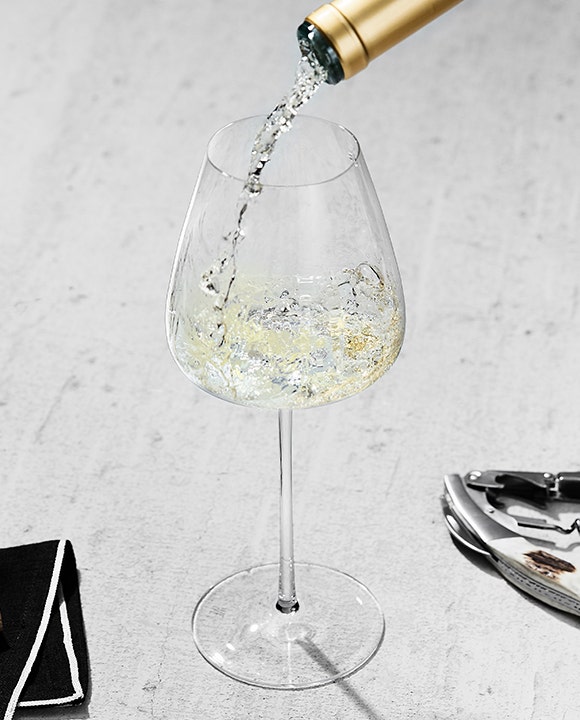
From the Shop
Find Your Wine a Home
Our selection of wine glasses is the best way to enjoy subtle aromas and bright flavors.
Published: May 1, 2024




